





New potatoes and fingerlings are both tiny, tender and delicious. The difference is maturity.
As more people turn to vegetable gardening, they are discovering the incomparable taste of newly-dug, fresh potatoes. Supermarkets will often have "new potatoes" or "baby potatoes" on their shelves, but these are usually not very new. There is more to a new potato than a small size. The most reliable way to obtain fresh, young new potatoes is to grow your own.
While the round, red waxy varieties such as 'Pontiac' are best known as new potatoes, many other varieties, such as 'Yukon Gold', are suitable for harvesting very young. Naturally thin-skinned types are best, as new potatoes are usually cooked and often eaten in their jackets, without peeling. Firm-fleshed varieties that will hold their shape are also preferable, because young potatoes are extremely tender and delicate. The thick-skinned, mealy baking potatoes are not the best choice for harvesting new.
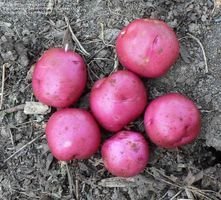 Dark Red Norland
Dark Red Norland
Gardeners eager for new potatoes usually select a very early variety such as 'Norland', one that matures in 90 days or less. But new potatoes are by definition immature and are harvested a month or more earlier than a fully-grown crop. As soon as the potato plant begins to bloom, it is a sign that its first tubers have begun to develop, but these are at first no larger than a pea. New potatoes are ideally harvested at about the size of a golf ball, while the skin is still very thin.
To harvest new potatoes, it is important to know how the potato plant grows. There are many different methods of planting potatoes, but in all cases the seed potato produces sprouts which grow into steams one or more feet high, and the new potato tubers develop from the sprouts, either underground or under a thick layer of mulch. This development takes place from bottom to top, with the first new tubers deepest in the earth and later ones sprouting as long as the plant continues to grow.
The impatient gardener, hungry for new potatoes, thus faces a dilemma. Digging up the entire plant at this stage means a much smaller harvest, sacrificing all the potatoes that will never be able to develop. But leaving them to grow risks ending up with too many potatoes that are no longer really new. If you do dig up the plants, only harvest as many potatoes as you can eat right away, the very same day if possible. New potatoes do not store well, and the point, after all, is for them to be fresh. For a continuous harvest of new potatoes, plant successive varieties with different maturities: early, mid-season and late.
Those of us who grow our potatoes under straw or some other deep mulch often try to carefully push the mulch aside to locate the earliest developing tubers and pinch them off the vine without disturbing it or the even newer potatoes just developing. Sometimes this works.
Many gardeners, however, are discovering another kind of potato—small, thin-skinned and even more delicious than new potatoes. These are the many varieties of fingerlings. Just about any way that new potatoes can be prepared, so can fingerlings. Unlike new potatoes, however, fingerlings are harvested when mature. In fact, despite their generally small size, most types of fingerlings are mid or late-season potatoes. This longer growing season allows fingerlings to develop intense, complex flavors that are often described as "nutty." Yet their skins remain thin and tender, with no need for peeling. Indeed, because of the irregular shape of most fingerlings, peeling would be impractical. Although the cooked skin slips off easily, most cooks don't consider this necessary. And of course the skin and the flesh directly beneath it is the most nutritious part of the potato.
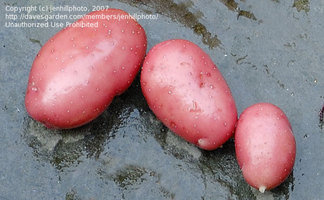
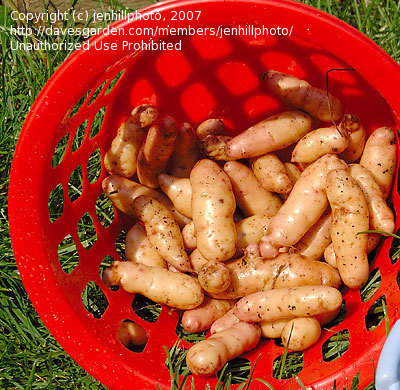
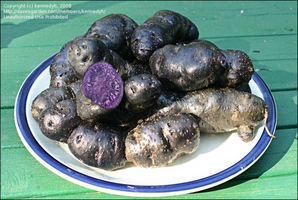 'French Fingerling'
'Rose Finn Apple'
'Purple Peruvian'
'French Fingerling'
'Rose Finn Apple'
'Purple Peruvian' Because fingerlings are best harvested when mature, the usual dilemma facing the grower of new potatoes does not apply. The entire vine can be dug when it has died back, with no loss of part of the harvest. Most varieties of fingerlings yield abundantly. Again unlike new potatoes, mature fingerlings store well when properly stored in a cool, dark location.
There are many different varieties of fingerling potatoes, but most of them are waxy or firm-fleshed, best suited for steaming, boiling or salads; they make the most delicious roasted potatoes.
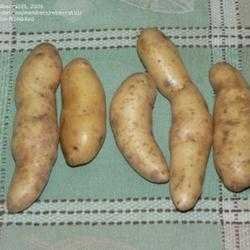
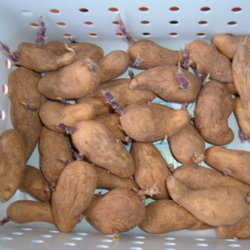 'Russian Banana'
'Swedish Peanut' - sprouted for planting
'Russian Banana'
'Swedish Peanut' - sprouted for planting
While fingerlings can in theory be harvested new, their flavor would be underdeveloped. Fortunately, gardeners who want early new potatoes and also the more complex taste of fingerlings have an easy solution. Grow both kinds: new potatoes for early summer and fingerlings for fall harvest.
Photo Credits from PlantFiles:
Thanks to
Farmerdill for Pontiac
Jennhillphoto for French Fingerling and Rose Finn Apple
Kennedyh for Purple Peruvian
Rebecca 101 for Dark Red Norland and Russian Banana
Copyright © www.100flowers.win Botanic Garden All Rights Reserved